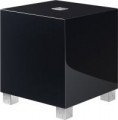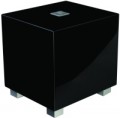Power
Rated power of the subwoofer. Technically, this is the highest average (rms) sound power at which the device can work normally (without sound distortion and damage to components) for an unlimited time. Simply put, the more powerful the subwoofer, the louder it is. The choice for this parameter depends primarily on the size of the space / room that is planned to be covered; detailed recommendations for different situations can be found in special sources.
Also, the power is directly related to the characteristics of the amplifier used with the subwoofer. For active subwoofers (see "Type"), this item actually indicates the nominal power of the built-in amplifier; the speaker itself can be more powerful, but it doesn't matter anymore. For passive models, the power rating corresponds to the highest amplifier power that can be connected to the speaker without the risk of damaging it at high volume.
Frequency range
The range of audio frequencies reproduced by the subwoofer. As a general rule, the wider the frequency range, the richer the sound and the more detail the speaker can convey. However, it is worth remembering that subwoofers as a class are designed for low and ultra-low frequencies in the range from 20 to 150 (sometimes 200) Hz. Therefore, in fact, a significant difference in sound is noticeable only with a large difference in the reproducible ranges (for example, 20-200 Hz and 50-150 Hz).
Also, do not forget that an extensive frequency range is not yet a guarantee of high-quality sound; and in some cases (for example, if the main speakers of the speaker also cope well with low frequencies), it may be completely redundant.
Speaker size
The diameter of the speaker(s) installed in the subwoofer.
It is believed that the larger the speaker (
15 ",
18 " and more), the more power it can produce and the deeper the bass will be on such acoustics. However, in modern subwoofers, manufacturers use various tricks that allow achieving good sound depth even with relatively small speaker sizes (
10 ",
8 "). Therefore, it is possible to compare different models only if they differ significantly in this indicator; and even then, in such cases, it is worth paying attention not so much to the speaker diameter as to the price category. The golden mean among sizes is
12-inch subwoofers.
Wireless connection
The presence of a
wireless connection in a subwoofer is most often Bluetooth: this standard is practically generally accepted in modern electronics, it is supported by the vast majority of smartphones, tablets and laptops. Note that we can talk about connecting an audio signal, as well as connecting to a device like a smartphone or tablet to manage settings. However, the latter option is not common — mainly in concert models, based on the ability to reconfigure the subwoofer even in a situation where there is no direct access to it.
If we talk about wireless sound transmission, then this option is convenient primarily from the point of view of choosing the optimal installation location: moving the subwoofer around the room, you do not need to mess with wires, and the Bluetooth range reaches 10 m. However, the quality of sound transmission with a wireless connection may be lower than with wired, but for bass this point is not as noticeable as for other frequency bands.
Material
- MDF. Medium-density fiberboard is one of the most popular materials for modern speaker cabinets, including subwoofers. This is due, on the one hand, to the relatively low cost and neat appearance, and on the other hand, to excellent acoustic characteristics.
MDF cases are found in “subs” for all purposes and price categories.
- Tree. Natural wood is well suited for low-frequency acoustic enclosures; its performance characteristics are comparable to MDF described above. At the same time, this material is considered more “natural” and has its own beautiful surface pattern, but is noticeably more expensive. Therefore, although
wooden cases are common, they are not as widespread as MDF.
- Plastic. The main advantage of plastic is its low cost, but it is very difficult to create a body with the necessary acoustic characteristics from this material. Therefore,
plastic subwoofers are extremely rare, mostly built-in models.
- Metal. In this case, we mean various alloys and aluminium models. The metal is highly durable, but the acoustic characteristics are far from optimal. This requires the use of various tricks, which respectively affect the price
of a metal subwoofer. Therefore, this option is quite rare.

